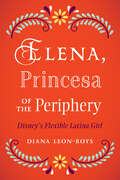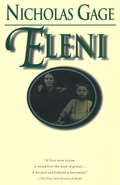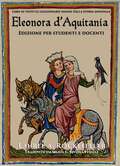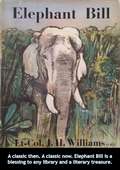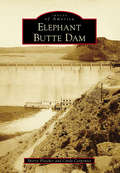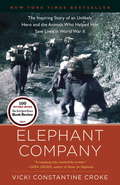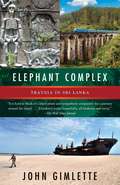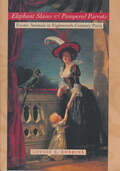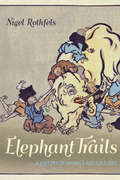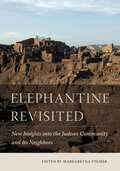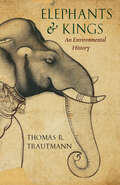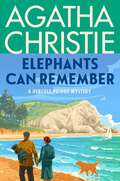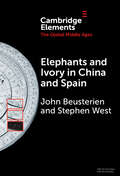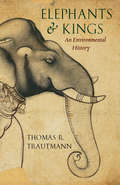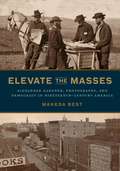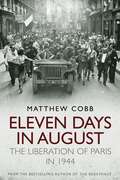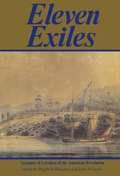- Table View
- List View
Elena, Princesa of the Periphery: Disney’s Flexible Latina Girl (Latinidad: Transnational Cultures in the United States)
by Diana Leon-BoysIn the summer of 2016, Disney introduced its first Latina princess, Elena of Avalor. Princesa of the Periphery explores this Disney property using multiple case studies to understand its approach to girlhood and Latinidad. Following the circuit of culture model, author Diana Leon-Boys teases out moments of complex negotiations by Disney, producers, and audiences as they navigate Elena’s circulation. Case studies highlight how a flexible Latinidad is deployed through corporate materials, social media pages, theme park experiences, and the television series to create a princess who is both marginal to Disney’s normative vision of princesshood and central to Disney’s claims of diversification. This multi-layered analysis of Disney’s mediated Latina girlhood interrogates the complex relationship between the U.S.’s largest ethnic minority and a global conglomerate that stands in for the U.S. on the global stage.
Eleni
by Nicholas GageIn 1948, in a Greek mountain village, Eleni Gatzoyiannis was arrested, tortured and shot. Her crime had been to help her children to escape from the Communist guerrillas during the Greek civil war who were abducting children and sending them to camps behind the Iron Curtain. Her son, Nicholas Gage, was then eight years old. Eventually he reached America and joined his father who was working there and sending money back to his family. In America Gage grew up to become one of The New York Times' best investigative reporters. He returned to Greece in 1977 as a Times correspondent and, gradually but increasingly obsessively, he began to reconstruct his mother's life and death. By the time he was finished he was ready to confront both his mother's executioners and his own memories. Eleni, an intensely moving and compelling book, is the fruit of his search for the truth.
Eleonora d'Aquitania: Edizione per studenti e docenti (Le leggendarie donne della storia mondiale #13)
by Laurel A. RockefellerAliénor era la donna più desiderata nel Medioevo – e non solo a causa della sua bellezza. Figlia maggiore del duca Guglielmo X d’Aquitania, ne ereditò, a quindici anni, l’immenso patrimonio e nello stesso anno, venne incoronata regina dei Franchi. Ma la bella duchessa non ebbe molta fortuna in amore, nonostante due matrimoni e dieci figli. I trovatori ne cantarono ampiamente la bellezza e la dilettarono con le gesta di re Artù ed i suoi cavalieri della tavola rotonda. Segnò il destino di due imperi emergenti e fece dell’Aquitania un fedele alleato dell’Inghilterra. La sua legenda perdura fino ai giorni nostri, questo libro racconta la sua emozionante storia. L'edizione per studenti e docenti è corredata da domande d'approfondimento alla fine di ogni capitolo.
Elephant Bill
by Lt.-Col. J. H. Williams O.B.E.A book comes along like this once in a lifetime. You read it as a small child, or even an adult, and never forget the images it conjures up of a wonderful Englishman who lives in the mysterious forests of faraway Burma and of the kind native people who teach him about their lovely country. But most of all, you never forget the elephants! For this is a story about those magnificent creatures. Though he was officially known as Lt. Colonel J. H. Williams, the author was known to the world at large as Elephant Bill. That is because he spent 25 years living with the elephants in the mountains and forests of Burma. There he trained them to haul teak logs out of the isolated jungles.Yet this is also a story of great courage, because when the Second World War struck it also came to Burma. The Japanese Imperial Army planned to confiscate the Burmese elephants, drafting them to make the bridges and railways they needed to invade India. When he learned of these plans to put his beloved animals to a war-like purpose, Elephant Bill knew what had to be done. The mighty kings of the jungle had to be evacuated to safety.This is thus the story not only of the peaceful days in the jungle, starting in 1921, but also the story of the largest elephant rescue in history. It tells the amazing account of how Elephant Bill, along with his friends and family, rode 45 of the great beasts across the mountains of Burma, before reaching safety in faraway India.A classic then. A classic now. Elephant Bill is a blessing to any library and a literary treasure.
Elephant Butte Dam
by Cindy Carpenter Sherry FletcherOn November 18, 1904, engineer B.M. Hall submitted his final report to the 12th National Irrigation Congress in El Paso, Texas. He concluded that the ideal location for a dam and reservoir would be a site in western New Mexico. A congressional act of February 25, 1905, authorized the construction of Elephant Butte Dam, the first civil engineering structure concerned with international allocation of water. Part of the Rio Grande Project, the dam and its reservoir would provide irrigation water for farmers along the Rio Grande in New Mexico, Texas, and Mexico. Today, Elephant Butte Dam is designated as a National Historical Engineer Landmark by the American Society of Civil Engineers (ASCE), the oldest national professional engineering society in the United States. The area is home to Elephant Butte Lake State Park, where camping, fishing, and water sports are enjoyed by both residents and tourists.
Elephant Company: The Inspiring Story of an Unlikely Hero and the Animals Who Helped Him Save Lives in World War II
by Vicki Constantine CrokeThe remarkable story of James Howard “Billy” Williams, whose uncanny rapport with the world’s largest land animals transformed him from a carefree young man into the charismatic war hero known as Elephant Bill<P> Billy Williams came to colonial Burma in 1920, fresh from service in World War I, to a job as a “forest man” for a British teak company. Mesmerized by the intelligence, character, and even humor of the great animals who hauled logs through the remote jungles, he became a gifted “elephant wallah.” Increasingly skilled at treating their illnesses and injuries, he also championed more humane treatment for them, even establishing an elephant “school” and “hospital.” In return, he said, the elephants made him a better man. The friendship of one magnificent tusker in particular, Bandoola, would be revelatory. In Elephant Company, Vicki Constantine Croke chronicles Williams’s growing love for elephants as the animals provide him lessons in courage, trust, and gratitude.<P> But Elephant Company is also a tale of war and daring. When Imperial Japanese forces invaded Burma in 1942, Williams joined the elite Force 136, the British dirty tricks department, operating behind enemy lines. His war elephants would carry supplies, build bridges, and transport the sick and elderly over treacherous mountain terrain. Now well versed in the ways of the jungle, an older, wiser Williams even added to his stable by smuggling more elephants out of Japanese-held territory. As the occupying authorities put a price on his head, Williams and his elephants faced his most perilous test. In a Hollywood-worthy climax, Elephant Company, cornered by the enemy, attempted a desperate escape: a risky trek over the mountainous border to India, with a bedraggled group of refugees in tow. Elephant Bill’s exploits would earn him top military honors and the praise of famed Field Marshal Sir William Slim.<P> Part biography, part war epic, and part wildlife adventure, Elephant Company is an inspirational narrative that illuminates a little-known chapter in the annals of wartime heroism.
Elephant Complex
by John GimletteNo one sees the world quite like John Gimlette. As The New York Times once noted, "he writes with enormous wit, indignation, and a heightened sense of the absurd." Writing for both the adventurer and the armchair traveler, he has an eye for unusually telling detail, a sense of wonder, and compelling curiosity for the inside story. This time, he travels to Sri Lanka, a country only now emerging from twenty-six years of civil war. Delving deep into the nation's story, Gimlette provides us with an astonishing, multifaceted portrait of the island today. His travels reveal the country as never before. Beginning in the exuberant capital, Colombo ("a hint of anarchy everywhere"), he ventures out in all directions: to the dry zones where the island's 5,800 wild elephants congregate around ancient reservoirs; through cinnamon country with its Portuguese forts; to the "Bible Belt" of Buddhism--the tsunami-ravaged southeast coast; then up into the great green highlands ("the garden in the sky") and Kandy, the country's eccentric, aristocratic Shangri-la. Along the way, a wild and often desperate history takes shape, a tale of great colonies (Arab, Portuguese, British, and Dutch) and of the cultural divisions that still divide this society. Before long, we're in Jaffna and the Vanni, crucibles of the recent conflict. These areas--the hottest, driest, and least hospitable--have been utterly devastated by war and are only now struggling to their feet.But this is also a story of friendship and remarkable encounters. In the course of his journey, Gimlette meets farmers, war heroes, ancient tribesmen, world-class cricketers, terrorists, a former president, old planters, survivors of great massacres--and perhaps some of their perpetrators. That's to say nothing of the island's beguiling fauna: elephants, crocodiles, snakes, storks, and the greatest concentration of leopards on Earth. Here is a land of extravagant beauty and profound devastation, of ingenuity and catastrophe, possessed of both a volatile past and an uncertain future--a place capable of being at once heavenly and hellish--all brought to vibrant, fascinating life here on the page.From the Hardcover edition.
Elephant Complex: Travels in Sri Lanka
by John GimletteNo one sees the world quite like John Gimlette. As The New York Times once noted, “he writes with enormous wit, indignation, and a heightened sense of the absurd.” Writing for both the adventurer and the armchair traveler, he has an eye for unusually telling detail, a sense of wonder, and compelling curiosity for the inside story. This time, he travels to Sri Lanka, a country only now emerging from twenty-six years of civil war. Delving deep into the nation’s story, Gimlette provides us with an astonishing, multifaceted portrait of the island today. His travels reveal the country as never before. Beginning in the exuberant capital, Colombo (“a hint of anarchy everywhere”), he ventures out in all directions: to the dry zones where the island’s 5,800 wild elephants congregate around ancient reservoirs; through cinnamon country with its Portuguese forts; to the “Bible Belt” of Buddhism—the tsunami-ravaged southeast coast; then up into the great green highlands (“the garden in the sky”) and Kandy, the country’s eccentric, aristocratic Shangri-la. Along the way, a wild and often desperate history takes shape, a tale of great colonies (Arab, Portuguese, British, and Dutch) and of the cultural divisions that still divide this society. Before long, we’re in Jaffna and the Vanni, crucibles of the recent conflict. These areas—the hottest, driest, and least hospitable—have been utterly devastated by war and are only now struggling to their feet.But this is also a story of friendship and remarkable encounters. In the course of his journey, Gimlette meets farmers, war heroes, ancient tribesmen, world-class cricketers, terrorists, a former president, old planters, survivors of great massacres—and perhaps some of their perpetrators. That’s to say nothing of the island’s beguiling fauna: elephants, crocodiles, snakes, storks, and the greatest concentration of leopards on Earth. Here is a land of extravagant beauty and profound devastation, of ingenuity and catastrophe, possessed of both a volatile past and an uncertain future—a place capable of being at once heavenly and hellish—all brought to vibrant, fascinating life here on the page.From the Hardcover edition.
Elephant Run
by Roland SmithIn 1941, bombs drop from the night skies of London, demolishing the apartment Nick Freestone lives in with his mother. Deciding the situation in England is too unstable, Nick's mother sends him to live with his father in Burma, hoping he will be safer living on the family's teak plantation. But as soon as Nick arrives, trouble erupts in the remote Burmese elephant village. Japanese soldiers invade, and Nick's father is taken prisoner. Nick is left stranded on the plantation, forced to work as a servant to the new rulers. As life in the village grows more dangerous for Nick and his young friend, Mya, they plan their daring escape. Setting off on elephant back, they will risk their lives to save Nick's father and Mya's brother from a Japanese POW camp.
Elephant Slaves & Pampered Parrots: Exotic Animals in Eighteenth-Century Paris (Animals, History, Culture)
by Louise E. RobbinsThis lively history “adds a new dimension to our understanding of 18th-century France” by exploring the Parisian fashion of importing exotic animals (American Historical Review).In 1775, a visitor to Laurent Spinacuta’s Grande Ménagerie at the annual winter fair in Paris would have seen two tigers, several kinds of monkeys, an armadillo, an ocelot, and a condor—in all, forty-two live animals. In the streets of the city, one could observe performing elephants and a fighting polar bear. Those looking for unusual pets could purchase parrots, flying squirrels, and capuchin monkeys. The royal menagerie at Versailles displayed lions, cranes, an elephant, a rhinoceros, and a zebra, which in 1760 became a major court attraction.For Enlightenment-era Parisians, exotic animals piqued scientific curiosity and conveyed social status. Their variety and accessibility were a boon for naturalists like Buffon, author of Histoire naturelle. Louis XVI use his menagerie to demonstrate his power, while critics saw his caged animals as metaphors of slavery and oppression. In her engaging account, Robbins considers nearly every aspect of France’s obsession with exotic fauna, from the animals’ transportation and care to the inner workings of the oiseleurs’ (birdsellers’) guild. Based on wide-ranging research, Elephant Slaves and Pampered Parrots offers a major contribution to the history of human-animal relations, eighteenth-century culture, and French colonialism.
Elephant Slaves and Pampered Parrots: Exotic Animals in Eighteenth-Century Paris (Animals, History, Culture)
by Louise E. RobbinsIn 1775, a visitor to Laurent Spinacuta's Grande Ménagerie at the annual winter fair in Paris would have seen two tigers, several kinds of monkeys, an armadillo, an ocelot, and a condor—in all, forty-two live animals. In Elephant Slaves and Pampered Parrots, Louise Robbins explains that exotic animals from around the world were common in eighteenth-century Paris. In the streets of the city, residents and visitors could observe performing elephants and a fighting polar bear. Those looking for unusual pets could purchase parrots, flying squirrels, and capuchin monkeys. The royal menagerie at Versailles displayed lions, cranes, an elephant, a rhinoceros, and a zebra, which in 1760 became a major court attraction.For Enlightenment-era Parisians, exotic animals both piqued scientific curiosity and conveyed social status. Their availability was a boon for naturalists like Buffon, author of the best-selling Histoire naturelle, who observed unusual species in a variety of locations around the city. Louis XVI saw his menagerie as a manifestation of his power and funded its upkeep accordingly, while critics used the caged animals as metaphors of slavery and political oppression amidst the growing political turmoil. In her engaging and often surprising account, Robbins considers nearly every aspect of France's obsession with exotic fauna, from the vast literature on exotic animals and the inner workings of the oiseleurs' (birdsellers') guild to how the animals were transported, housed, and cared for. Based on wide-ranging and imaginative research, Elephant Slaves and Pampered Parrots stands as a major contribution to the history of human-animal relations, eighteenth-century culture, and French colonialism.
Elephant Trails: A History of Animals and Cultures (Animals, History, Culture)
by Nigel RothfelsWhy have elephants—and our preconceptions about them—been central to so much of human thought?From prehistoric cave drawings in Europe and ancient rock art in Africa and India to burning pyres of confiscated tusks, our thoughts about elephants tell a story of human history. In Elephant Trails, Nigel Rothfels argues that, over millennia, we have made elephants into both monsters and miracles as ways to understand them but also as ways to understand ourselves.Drawing on a broad range of sources, including municipal documents, zoo records, museum collections, and encounters with people who have lived with elephants, Rothfels seeks out the origins of our contemporary ideas about an animal that has been central to so much of human thought. He explains how notions that have been associated with elephants for centuries—that they are exceptionally wise, deeply emotional, and have a special understanding of death; that they never forget, are beloved of the gods, and suffer unusually in captivity; and even that they are afraid of mice—all tell part of the story of these amazing beings. Exploring the history of a skull in a museum, a photograph of an elephant walking through the American South in the early twentieth century, the debate about the quality of life of a famous elephant in a zoo, and the accounts of elephant hunters, Rothfels demonstrates that elephants are not what we think they are—and they never have been. Elephant Trails is a compelling portrait of what the author terms "our elephant."
Elephantine Revisited: New Insights into the Judean Community and Its Neighbors
by Margaretha FolmerThe Judean community at Elephantine has long fascinated historians of the Persian period. This book, with its stellar assemblage of important scholarly voices, provides substantive new insights and approaches that will advance the study of this well-known but not entirely understood community from fifth-century BCE Egypt. Since Bezalel Porten’s pioneering Archives from Elephantine, published in 1968, the discourse on the subject of the community of Elephantine during the Persian period has changed considerably, due to new data from excavations, the discovery and publication of previously unknown texts, and original scholarly insights and avenues of inquiry. Running the gamut from archaeological to linguistic investigations and encompassing legal, literary, religious, and other aspects of life in this Judean community, this volume stands at a crossroads of research that extends from Hebrew Bible studies to the history of early Jewish communities. It also features fourteen new Aramaic ostraca from Aswan. The volume will appeal to students and scholars of the Hebrew Bible and ancient Judaism, as well as to a wider audience of Egyptologists, Semitists, and specialists in ancient Near Eastern studies. In addition to the editor, the contributors to this volume include Annalisa Azzoni, Bob Becking, Alejandro F. Botta, Lester L. Grabbe, Ingo Kottsieper, Reinhard G. Kratz, André Lemaire, Hélène Nutkowicz, Beatrice von Pilgrim, Cornelius von Pilgrim, Bezalel Porten, Ada Yardeni, and Ran Zadok. Moreover, a video recording of an interview conducted with Porten on his long career in Elephantine studies accompanies the book through a link on the Eisenbrauns website.
Elephantine Revisited: New Insights into the Judean Community and Its Neighbors
by Margaretha FolmerThe Judean community at Elephantine has long fascinated historians of the Persian period. This book, with its stellar assemblage of important scholarly voices, provides substantive new insights and approaches that will advance the study of this well-known but not entirely understood community from fifth-century BCE Egypt. Since Bezalel Porten’s pioneering Archives from Elephantine, published in 1968, the discourse on the subject of the community of Elephantine during the Persian period has changed considerably, due to new data from excavations, the discovery and publication of previously unknown texts, and original scholarly insights and avenues of inquiry. Running the gamut from archaeological to linguistic investigations and encompassing legal, literary, religious, and other aspects of life in this Judean community, this volume stands at a crossroads of research that extends from Hebrew Bible studies to the history of early Jewish communities. It also features fourteen new Aramaic ostraca from Aswan. The volume will appeal to students and scholars of the Hebrew Bible and ancient Judaism, as well as to a wider audience of Egyptologists, Semitists, and specialists in ancient Near Eastern studies. In addition to the editor, the contributors to this volume include Annalisa Azzoni, Bob Becking, Alejandro F. Botta, Lester L. Grabbe, Ingo Kottsieper, Reinhard G. Kratz, André Lemaire, Hélène Nutkowicz, Beatrice von Pilgrim, Cornelius von Pilgrim, Bezalel Porten, Ada Yardeni, and Ran Zadok. Moreover, a video recording of an interview conducted with Porten on his long career in Elephantine studies accompanies the book through a link on the Eisenbrauns website.
Elephants & Kings: An Environmental History
by Thomas R. TrautmannBecause of their enormous size, elephants have long been irresistible for kings as symbols of their eminence. In early civilizations—such as Egypt, Mesopotamia, the Indus Civilization, and China—kings used elephants for royal sacrifice, spectacular hunts, public display of live captives, or the conspicuous consumption of ivory—all of them tending toward the elephant’s extinction. The kings of India, however, as Thomas R. Trautmann shows in this study, found a use for elephants that actually helped preserve their habitat and numbers in the wild: war. Trautmann traces the history of the war elephant in India and the spread of the institution to the west—where elephants took part in some of the greatest wars of antiquity—and Southeast Asia (but not China, significantly), a history that spans 3,000 years and a considerable part of the globe, from Spain to Java. He shows that because elephants eat such massive quantities of food, it was uneconomic to raise them from birth. Rather, in a unique form of domestication, Indian kings captured wild adults and trained them, one by one, through millennia. Kings were thus compelled to protect wild elephants from hunters and elephant forests from being cut down. By taking a wide-angle view of human-elephant relations, Trautmann throws into relief the structure of India’s environmental history and the reasons for the persistence of wild elephants in its forests.
Elephants Can Remember: A Hercule Poirot Mystery: The Official Authorized Edition (Hercule Poirot Mysteries #36)
by Agatha ChristieA classic Hercule Poirot investigation, Agatha Christie’s Elephants Can Remember has the expert detective delving into an unsolved crime from the past involving the strange death of a husband and wife.Hercule Poirot stood on the clifftop. Here, many years earlier, there had been a fatal accident followed by the grisly discovery of two bodies—a husband and wife who had been shot dead.But who had killed whom? Was it a suicide pact? A crime of passion? Or cold-blooded murder? Poirot delves into the past and discovers that “old sins leave long shadows.”
Elephants and Ivory in China and Spain (Elements in the Global Middle Ages)
by John Beusterien Stephen WestThe Element provides a global history of ivory and elephants, acknowledging the individuality and dignity of the elephants that provided that ivory. Sections on China include the first translations of texts about the cultural importance of elephants and ivory in the Song Dynasty (960–1279) and an examination of an ivory stave (huban 笏板), crafted from an Asian elephant tusk (Elephas maximus), carried by officials in court and other formal rituals. Sections on Spain examine the value of ivory during the reign of King Alfonso X of Castille (1221–1284) and the Virxe Abrideira (ca. 1260–1275), an ivory Virgin and Child statuette owned by Queen Violante of Aragon (1236–1301), crafted from an African elephant tusk (Loxodonta africana). The Element concludes by offering a pedagogy from a comparative literature perspective about Sunjata (c.1226), an epic from the Mali empire in West Africa, an important source for thirteenth-century global ivory markets.
Elephants and Kings: An Environmental History
by Thomas R. TrautmannBecause of their enormous size, elephants have long been irresistible for kings as symbols of their eminence. In early civilizations--such as Egypt, Mesopotamia, the Indus Civilization, and China--kings used elephants for royal sacrifice, spectacular hunts, public display of live captives, or the conspicuous consumption of ivory--all of them tending toward the elephant's extinction. The kings of India, however, as Thomas R. Trautmann shows in this study, found a use for elephants that actually helped preserve their habitat and numbers in the wild: war. Trautmann traces the history of the war elephant in India and the spread of the institution to the west--where elephants took part in some of the greatest wars of antiquity--and Southeast Asia (but not China, significantly), a history that spans 3,000 years and a considerable part of the globe, from Spain to Java. He shows that because elephants eat such massive quantities of food, it was uneconomic to raise them from birth. Rather, in a unique form of domestication, Indian kings captured wild adults and trained them, one by one, through millennia. Kings were thus compelled to protect wild elephants from hunters and elephant forests from being cut down. By taking a wide-angle view of human-elephant relations, Trautmann throws into relief the structure of India's environmental history and the reasons for the persistence of wild elephants in its forests.
Elevate the Masses: Alexander Gardner, Photography, and Democracy in Nineteenth-Century America
by Makeda BestAlexander Gardner is best known for his innovative photographic history of the Civil War. What is less known is the extent to which he was involved in the international workers’ rights movement. Tying Gardner’s photographic storytelling to his transatlantic reform activities, this book expands our understanding of Gardner’s career and the work of his studio in Washington, DC, by situating his photographic production within the era’s discourse on social and political reform.Drawing on previously unknown primary sources and original close readings, Makeda Best reveals how Gardner’s activism in Scotland and photography in the United States shared an ideological foundation. She reads his Photographic Sketch Book of the War as a politically motivated project, rooted in Gardner’s Chartist and Owenite beliefs, and illuminates how its treatment of slavery is primarily concerned with the harm that the institution posed to the United States’ reputation as a model democracy. Best shows how, in his portraiture, Gardner celebrated Northern labor communities and elevated white immigrant workers, despite the industrialization that degraded them. She concludes with a discussion of Gardner’s promotion of an American national infrastructure in which photographers and photography played an integral role.Original and compelling, this reconsideration of Gardner’s work expands the contribution of Civil War photography beyond the immediate narrative of the war to comprehend its relation to the vigorous international debates about democracy, industrialization, and the rights of citizens. Scholars working at the intersection of photography, cultural history, and social reform in the nineteenth century on both sides of the Atlantic will find Best’s work invaluable to their own research.
Elevate the Masses: Alexander Gardner, Photography, and Democracy in Nineteenth-Century America
by Makeda BestAlexander Gardner is best known for his innovative photographic history of the Civil War. What is less known is the extent to which he was involved in the international workers’ rights movement. Tying Gardner’s photographic storytelling to his transatlantic reform activities, this book expands our understanding of Gardner’s career and the work of his studio in Washington, DC, by situating his photographic production within the era’s discourse on social and political reform.Drawing on previously unknown primary sources and original close readings, Makeda Best reveals how Gardner’s activism in Scotland and photography in the United States shared an ideological foundation. She reads his Photographic Sketch Book of the War as a politically motivated project, rooted in Gardner’s Chartist and Owenite beliefs, and illuminates how its treatment of slavery is primarily concerned with the harm that the institution posed to the United States’ reputation as a model democracy. Best shows how, in his portraiture, Gardner celebrated Northern labor communities and elevated white immigrant workers, despite the industrialization that degraded them. She concludes with a discussion of Gardner’s promotion of an American national infrastructure in which photographers and photography played an integral role.Original and compelling, this reconsideration of Gardner’s work expands the contribution of Civil War photography beyond the immediate narrative of the war to comprehend its relation to the vigorous international debates about democracy, industrialization, and the rights of citizens. Scholars working at the intersection of photography, cultural history, and social reform in the nineteenth century on both sides of the Atlantic will find Best’s work invaluable to their own research.
Elevating the Game: The History and Aesthetics of Black Men in Basketball
by Nelson GeorgeThe author of "The Michael Jackson Story" argues that black basketball players have reinvented the game. By researching the history of basketball George exposes African American icons who have revolutionized dribbling. He tells the stories of those black individuals who advanced the sport's technique, and who influenced its strategy. The author skillfully narrates the African American history that is integral to the history of basketball.
Eleven Days in August: The Liberation of Paris in 1944
by Matthew Cobb'I had thought that for me there could never again be any elation in war. But I had reckoned without the liberation of Paris - I had reckoned without remembering that I might be a part of that richly historic day. We were in Paris on the first day - one of the great days of all time.' (Ernie Pyle, US war correspondent)The liberation of Paris was a momentous point in twentieth-century history, yet it is now largely forgotten outside France. Eleven Days in August is a pulsating hour-by-hour reconstruction of these tumultuous events that shaped the final phase of the war and the future of France, told with the pace of a thriller. While examining the conflicting national and international interests that played out in the bloody street fighting, it tells of how, in eleven dramatic days, people lived, fought and died in the most beautiful city in the world. Based largely on unpublished archive material, including secret conversations, coded messages, diaries and eyewitness accounts, Eleven Days in August shows how these August days were experienced in very different ways by ordinary Parisians, Resistance fighters, French collaborators, rank-and-file German soldiers, Allied and French spies, the Allied and German High Commands.Above all, it shows that while the liberation of Paris may be attributed to the audacity of the Resistance, the weakness of the Germans and the strength of the Allies, the key to it all was the Parisians who by turn built street barricades and sunbathed on the banks of the Seine, who fought the Germans and simply tried to survive until the Germans finally surrendered, in a billiard room at the Prefecture of Police. One of the most iconic moments in the history of the twentieth century had come to a close, and the face of Paris would never be the same again.
Eleven Exiles: Accounts of Loyalists of the American Revolution
by John Grant Phyllis R. BlakeleyEleven Exiles is a personal account of the American Revolution. By focusing on eleven different people who were on the losing side of the American Revolution, and who had to make new lives for themselves in what remained of British North America. Eleven Exiles reflects the major themes of those turbulent years. What were the attitudes of these men and women toward the significant social and political ideas of the time? What motivated them to leave their home and move to a wildnerness? What challenges and hardships did they face?
Eleven Scandals to Start to Win a Duke's Heart (Love By Numbers #3)
by Sarah MacLeanShe lives for passion.Bold, impulsive, and a magnet for trouble, Juliana Fiori is no simpering English miss. She refuses to play by society's rules: she speaks her mind, cares nothing for the approval of the ton, and can throw a punch with remarkable accuracy. Her scandalous nature makes her a favorite subject of London's most practiced gossips . . . and precisely the kind of woman The Duke of Leighton wants far far away from him.He swears by reputation.Scandal is the last thing Simon Pearson has room for in his well-ordered world. The Duke of Disdain is too focused on keeping his title untainted and his secrets unknown. But when he discovers Juliana hiding in his carriage late one evening--risking everything he holds dear--he swears to teach the reckless beauty a lesson in propriety. She has other plans, however; she wants two weeks to prove that even an unflappable duke is not above passion.
Eleven Scandals to Start to Win a Duke's Heart: Number 3 in series (Love by Numbers #3)
by Sarah MacLean'Fabulous' Eloisa James'Smart, sexy, and always romantic' Julia Quinn'For a smart, witty and passionate historical romance, I recommend anything by Sarah MacLean' Lisa KleypasShe lives for passion. Bold, impulsive, and a magnet for trouble, Juliana Fiori is no simpering English miss. She refuses to play by society's rules: she speaks her mind, cares nothing for the approval of the ton, and can throw a punch with remarkable accuracy. Her scandalous nature makes her a favorite subject of London's most practiced gossips . . . and precisely the kind of woman the Duke of Leighton wants far far away from him. He swears by reputation. Scandal is the last thing Simon Pearson has room for in his well-ordered world. The Duke of Disdain is too focused on keeping his title untainted and his secrets unknown. But when he discovers Juliana hiding in his carriage late one evening - risking everything he holds dear - he swears to teach the reckless beauty a lesson in propriety. She has other plans, however; she wants two weeks to prove that even an unflappable duke is not above passion.This is the third novel in the Regency romance Love By Numbers trilogy by New York Times bestselling author Sarah MacLean - perfect for fans of Lisa Kleypas and Eloisa JamesLove By Numbers series:Nine Rules to Break When Romancing a RakeTen Ways to Be Adored When Landing a LordEleven Scandals to Start to Win a Duke's HeartPraise for Sarah MacLean:'Sarah MacLean has reignited the romance genre with a bolder edge' The New Yorker'Funny, smart, feminist and roastingly hot' BookRiot.com'Do yourself a favor and discover the compelling magic of Sarah MacLean' Amanda Quick'MacLean writes with an entirely unique blend of elegance and ferocity that bursts from every page' Entertainment Weekly'Great chemistry, intelligence and sparkling humor' RT Book Reviews
